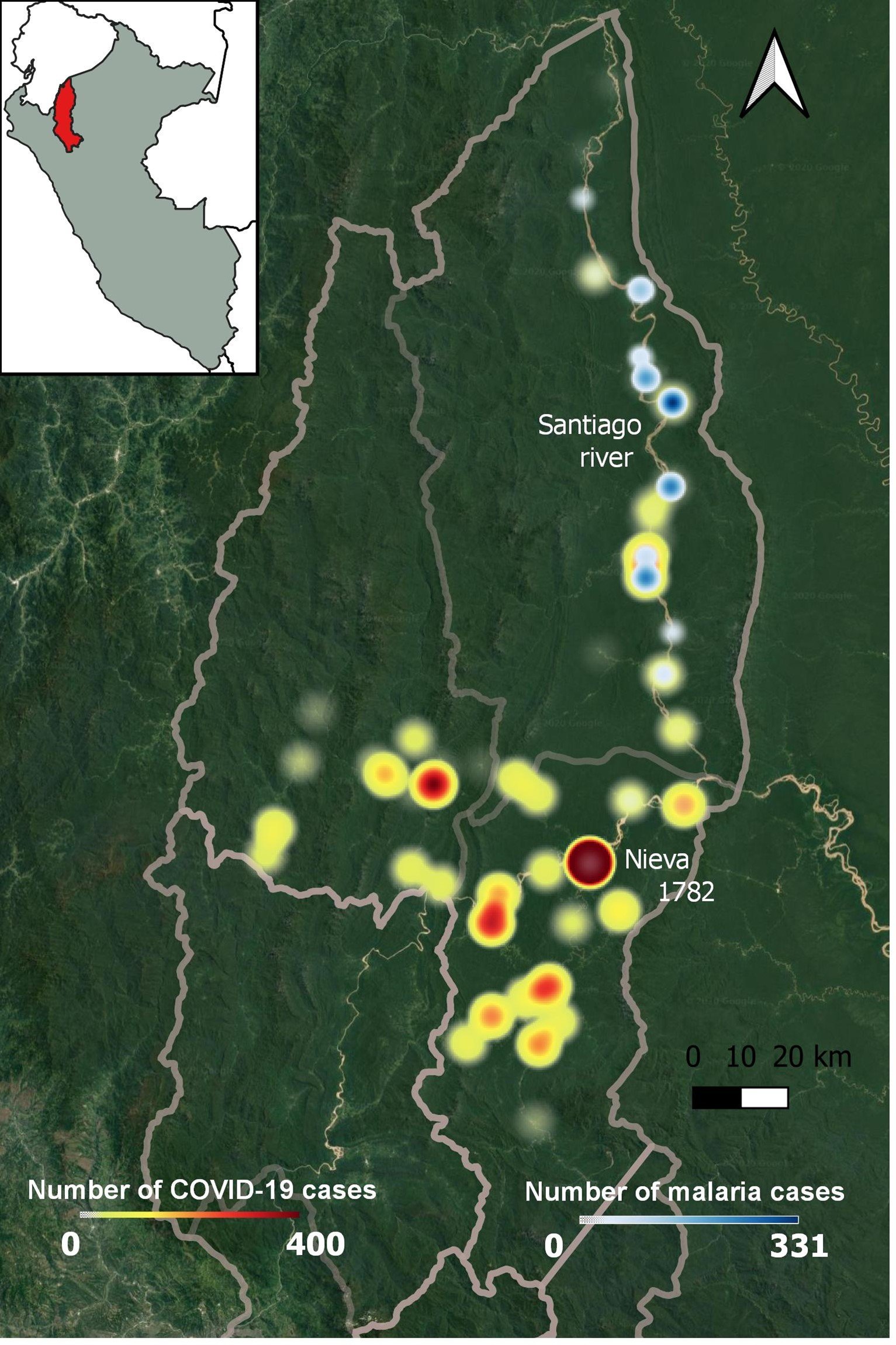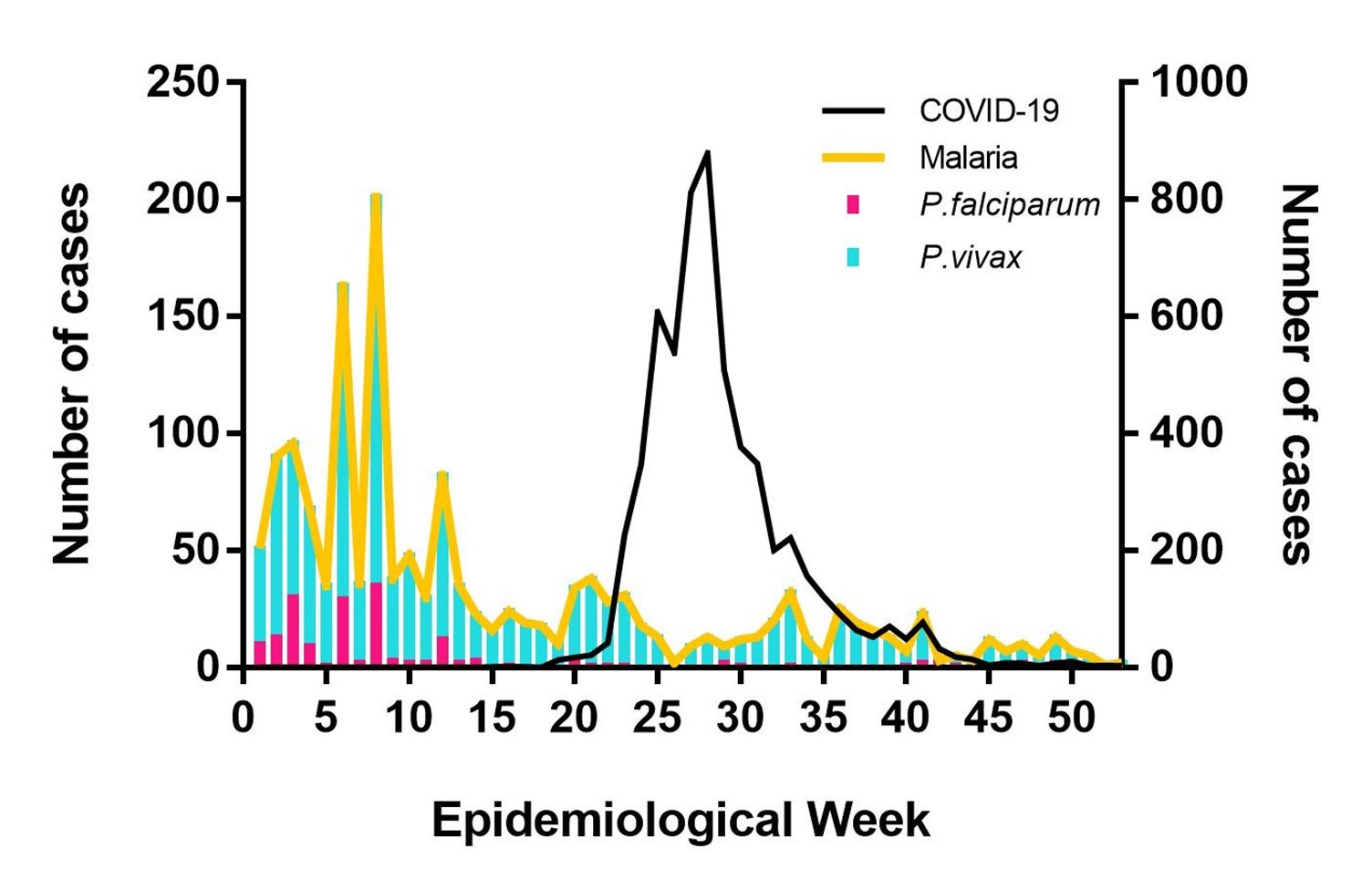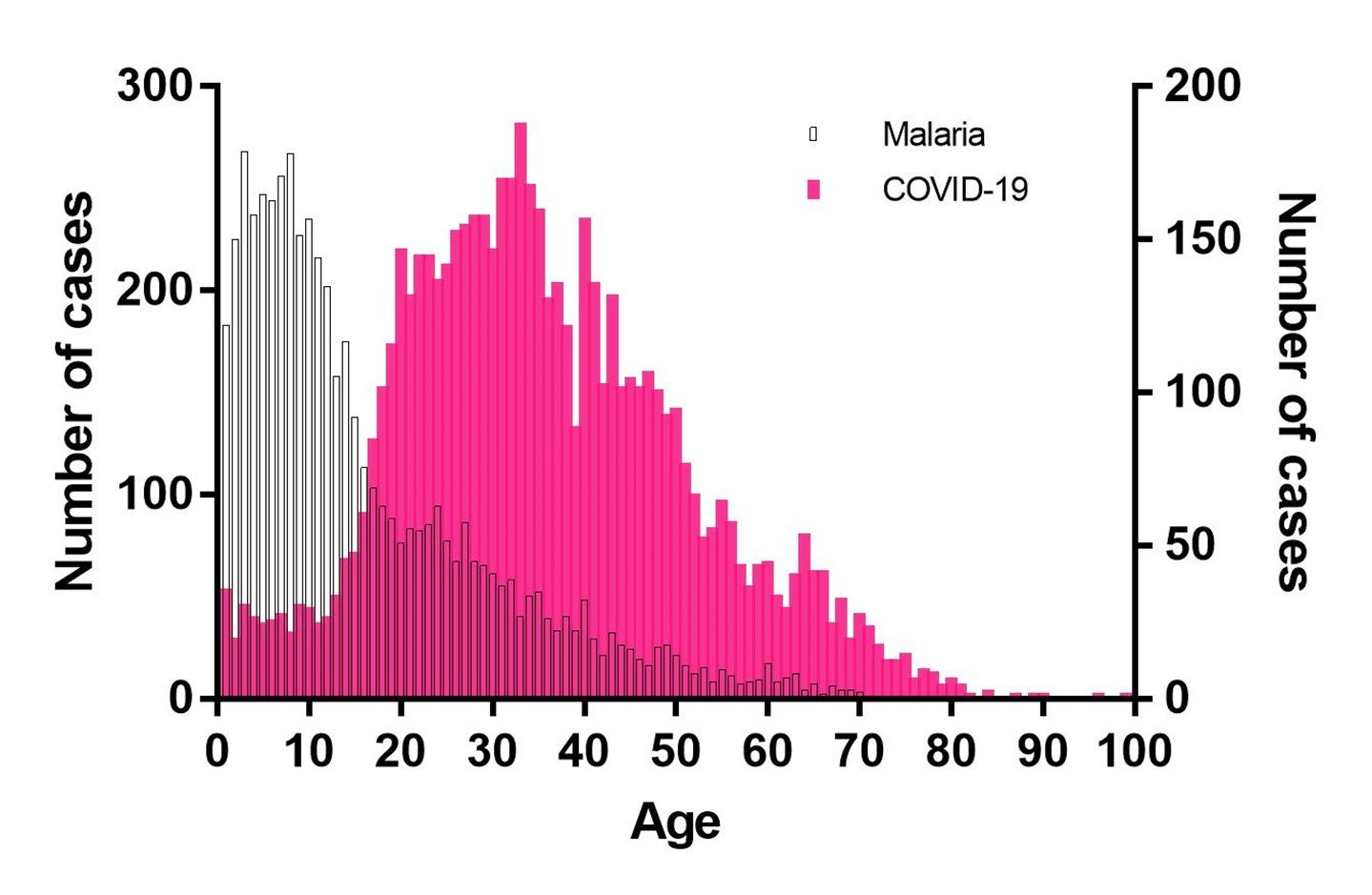ARTICULO ORIGINAL
REVISTA DE LA FACULTAD DE MEDICINA HUMANA 2022 - Universidad Ricardo Palma10.25176/RFMH.v22i3.5044
MALARIA AND COVID-19 IN NATIVE COMMUNITIES OF AMAZONAS, PERU
MALARIA Y COVID-19 EN COMUNIDADES NATIVAS DE AMAZONAS, PERÚ
Cecilia Pajuelo-Reyes1, Luis M. Rojas1,2, Christian J. Campos1,2, Milagros
Saavedra-Samillan1, Juan R. Tejedo1,3, Pershing Bustamante2, Stella M.
Chenet1,4, Rafael Tapia-Limonchi1,4
1Universidad Nacional Toribio Rodríguez de Mendoza de Amazonas (UNTRM), Instituto de Enfermedades
Tropicales (IET), Perú
2Dirección Regional de Salud de Amazonas (DIRESA), Amazonas, Perú
3Deparment of Molecular Biology and Biochemical Engineering, Universidad Pablo de Olavide
Seville, Spain.
4Instituto de Investigaciones en Ciencias Biomédicas, Universidad Ricardo Palma. Lima, Perú.
ABSTRACT
introduction In recent years, the number of malaria cases in native communities from Condorcanqui, Amazonas has considerably increased. Plasmodium vivax malaria is endemic in the region and the re-introduction of P. falciparum was reported in 2019. Methods Here, we compiled and analyzed malaria and COVID-19 data reported by the Regional Direction of Health (DIRESA) during the 2020. Additionally, we performed an odds ratio analysis to evaluate significant associations between COVID-19 symptoms and previous malaria infections. Results In 2020, 1547 malaria (97% were P. vivax) and 5968 COVID-19 cases were reported. Furthermore, 96 patients got COVID-19 after getting a malaria infection. From these, 87 were symptomatic (90.6%), and mostly adults, ages 30 to 59 (62.3%). Also, we found that malaria previous infections represent a risk for the presence of symptoms such as fever, cough, throat pain, and respiratory difficulty. Nevertheless, there was no significant association between these cases and hospitalization or death. Conclusion Our analysis suggests that previous malaria infections might affect COVID-19 symptomatology, which highlights the importance of a continuing control and surveillance malaria program to avoid potential syndemics with COVID-19.
Keywords: Malaria; COVID-19; Tropical disease; Syndemic (Source: MeSH NLM).
RESUMEN
Introducción En los últimos años, el número de casos de malaria en las comunidades nativas de Condorcanqui, Amazonas ha aumentado considerablemente. La malaria por Plasmodium vivax es endémica en la región y en 2019 fue reportada la reintroducción de P. falciparum. Métodos En este estudio, recopilamos y analizamos los datos de malaria y COVID-19 reportados por la Dirección Regional de Salud (DIRESA) durante el 2020. Además, realizamos un análisis de razón de posibilidades “odds ratio” para evaluar las asociaciones significativas entre los síntomas de la COVID-19 y las infecciones previas de malaria. Resultados En el 2020, se reportaron 1547 casos de malaria (97% por P. vivax) y 5968 de COVID-19. Por otro lado, 96 pacientes contrajeron COVID-19 después de contraer una infección de malaria. De éstos, 87 eran sintomáticos (90,6%) y en su mayoría adultos de 30 a 59 años (62,3%). Además, encontramos que las infecciones previas de malaria están asociadas a la presencia de síntomas como fiebre, tos, dolor de garganta y dificultad respiratoria. Sin embargo, no hubo asociación significativa entre estos casos y la hospitalización o la muerte. Conclusión Nuestro análisis sugiere que las infecciones previas por malaria podrían afectar la sintomatología de la COVID-19, lo que destaca la importancia de un programa continuo de control y vigilancia de la malaria para evitar posibles sindemias con la COVID-19.
Palabras Clave: Malaria; COVID-19; Enfermedad tropical; Sindemia (fuente: DeCS BIREME).
INTRODUCTION
Malaria is a widespread disease throughout the world and especially in tropical and subtropical regions.
In Peru, the cases represent 6% of the total for all of America. In 2021, the majority of cases occurred
in Loreto (84.6%), Amazonas (9.8%), Junín (3.4%), and San Martín (0.8%) (1).
In particular, native communities are the most affected. These populations lack basic services (such as
electricity or drinking water) and the main means of transportation is by the river. The province of
Condorcanqui, on the northeastern side of the Amazon region in Peru, has more than 300 native
communities and 42,700 inhabitants, with a majority population of the Awajun and Wampis ethnic groups.
Here, malaria is endemic and P. vivax is more prevalent than P.falciparum infections. Between 2015 and
2018, only four imported cases of P.falciparum were reported. In 2020, an outbreak of P. falciparum,
increased the risk of malaria severity and mortality (2). On the other hand,
COVID-19 has had the considerable transmission in these populations, with a high cumulative incidence of
63.84/1000 inhabitants and a much lower mortality rate (0.95%) than the national average (3).
Despite the possible concurrent infection of COVID-19 and malaria, little is known about the
clinical course of coinfected patients. Malaria-induced immunomodulation has been shown to have a
protective effect against severe manifestations of respiratory viral infections (4). A study in Kenya showed that children hospitalized with a diagnosis of
Influenza and Malaria were less likely to progress to respiratory distress than those with only
influenza (5). Furthermore, co-infection was found to suppress the production
of pulmonary cytokines and decrease the recruitment of immune cells to the lung (6). The impact of malaria on clinical outcomes of COVID-19 has remained
unaddressed by longitudinal studies.
In this article, we present a preliminary analysis of the epidemiology of malaria in the native
communities of Condorcanqui, Amazonas, Peru, and assess the impact of the COVID-19 pandemic during the
year 2020. This is the first study to describe the behavior of COVID -19 in an endemic area for malaria.
Finally, we suggest a syndemic approach and additional studies to learn more about the effect of malaria
and other tropical infections and their relationship with respiratory infections such as COVID-19.
METHODS
The Regional Directorate of Health - Amazonas (DIRESA-Amazonas), in collaboration with the Condorcanqui Health Network and the Institute of Tropical Diseases of the Toribio Rodríguez National University of Mendoza, has carried out an analysis of the data on Malaria infections that have been reported in the native communities of Rio Santiago, Condorcanqui province, Amazonas region during 2020. Additionally, the analysis of COVID-19 cases in the province of Condorcanqui, confirmed serologically and notified during the year 2020, was carried out. Data consists of open demographic information, clinical characteristics, and contact history. This investigation was carried out as part of the epidemiological surveillance approved by DIRESA-Amazonas.
Study site
The Province of Condorcanqui is located in the northern jungle of the Amazon Region of Peru and is part of the Marañón Basin. This province is limited by the Republic of Ecuador to the Northwest; the region of Loreto to the East, and the provinces of Bagua, Utcubamba, and Bongará to the South. Condorcanqui has three districts: Nieva, El Cenepa, and Río Santiago, and has an area of 17,892 km², with an estimated population of 42,470 inhabitants (7). The rugged relief of this region has an extensive river network made up of the Marañón River and its tributaries Cenepa, Nieva, and Santiago, as well as a large number of streams of different flows and sizes. Condorcanqui has a humid tropical climate with temperatures that can reach 35 °C, average annual rainfall around 4,800 mm, and relative humidity above 90%. The rainy season occurs from October to December but could last until May (8).
Malaria and COVID-19 Database
In this study, we compiled and analyzed malaria and COVID-19 data reported by DIRESA-Amazonas during the year 2020. In addition, we performed an odds ratio analysis with a 95 % confidence interval to assess significant associations between COVID-19 symptoms and prior malaria infection. Statistical analyzes were performed using the IBM SPSS Statistics program (version 21.0), and graphs were made using GraphPad Prism (version 8). The heat map was performed using QGIS version 3.10.8 to assess the spatial distribution of malaria and COVID-19 cases in Condorcanqui.
Resuls
The descriptive analysis based on the information collected from the DIRESA-Amazonas open databases shows that during 2020 in the native communities located along the Santiago River, the transmission of the SARS-CoV-2 virus occurred in a population affected by malaria. Thus, 1,547 cases of malaria (97% due to P. vivax) and 5,968 cases of COVID-19 were reported in Condorcanqui (Figure 1, 2A). Although they are official data, the restrictions caused by the state of emergency and the limited access to the communities could have caused the data to be underestimated. Santa María de Nieva is the capital of the province of Condorcanqui. In this city alone, 1,792 cases of COVID-19 were reported, with the rest of the cases being distributed among the other districts of the province. However, the communities of the Río Santiago district were affected by both Malaria and COVID-19 diseases (Figure 1).

In 2020, the largest report of malaria cases occurred in the first 10 weeks and coincides with the active search for outbreak investigation where the re-emergence of P.falcip arum after 13 years. While the peak of COVID-19 cases was reported between weeks 25 and 30. The decrease in the reporting of malaria cases during a state of emergency shows how malaria surveillance was affected (Figure 2A). As for the age group most affected by malaria, it was children under 11 years of age (48.4%) and for cases of COVID-19, it mostly affected adults between 30 and 59 years of age (62.3%) (Figure 2B).

A. Number of cases per epidemiological week in 2020. en 2020.
As for the age group most affected by malaria, it was children under 11 years of age (48.4%) and for cases of COVID-19, it mostly affected adults between 30 and 59 years of age (62.3%) (Figure 2B).
In order to measure the association between previous malaria infection and COVID-19 symptoms, an
odds ratio analysis was applied. It was found that having previously suffered from malaria is
significantly associated with the presence of COVID-19 symptoms such as fever, cough, sore throat, and
shortness of breath. However, regarding hospitalization or death from COVID-19, no significant
association was found for these patients. Likewise, no significance is observed with symptoms such as
chest pain or abnormal sounds in the lungs (Figure 3). In the relationship between
recurrent malaria infections and COVID-19 symptoms, no statistical significance was found either.
Finally, four people were diagnosed with malaria and COVID-19 in a period of fewer than 30 days. They
did not present severe symptoms of COVID-19 and recovered without requiring hospitalization.

DISCUSIÓN
By 2022, in America, Peru ranks fifth in a number of confirmed infections by Sars-COV-2 with 3,581,524
cases, while Peru ranks second in a number of deaths with 213,205 (11). The
north-eastern region of the country is home to around 210,000 natives of different ethnic groups. These
communities often live in isolation and in conditions that make them vulnerable to various tropical
communicable diseases and currently to COVID-19
(12). During the pandemic, worldwide, the focus of attention was on COVID-19,
so efforts to cut community transmission caused the neglect of other diseases such as malaria,
accentuating the problem in endemic countries, such as in many countries of Africa (13,14) and in Peru (15). After
Iquitos, Amazonas is the second region with the most cases of malaria, mainly concentrated in the
district of Río Santiago, province of Condorcanqui. This behavior has been evidenced since 2010 due to
the transmission of P. vivax infections P. falciparum in the region (2) .
Although it is possible that the restrictive measures due to the pandemic affect the real impact on malaria transmission, an underestimation of the situation cannot be ruled out, due to the reduction of control measures and a consequent resurgence of malaria or expansion to other bordering areas such as Amazon. As reported for Iquitos, where there is a notable reduction in the number of cases after the intervention by the Ministry of Health's "Malaria Cero" program (15).
Malaria circulation could increase susceptibility to COVID-19 disease and affect morbidity and mortality rates. However, there are reports of the importance of the balance of the immune response against infections, and the possibility that the preparation with Plasmodiummay has favorable effects. It has recently been reported that the immune response that appears during malaria infection could protect against Sars CoV-2 infection, and decrease the risk of severe COVID-19 (16,17),18). Likewise, co-infection with Plasmodium spp could suppress the production of pulmonary cytokines and decrease the recruitment of inflammatory cellular components to the lungs (4,5).
In the analysis carried out in the province of Condorcanqui in Amazonas, Peru, we found that in the communities of the Rio Santiago district, where the majority of malaria cases occur in the region, they have also reported cases of COVID-19. Interestingly, reported Malaria cases primarily affect children under 11 years of age, while COVID-19 cases affect adults. This is due to the fact that children with COVID-19 produce a rapid and effective immune response to the virus, with the majority of cases being asymptomatic. This could be due to the low immune status of children against malaria, while more is known about the immunological susceptibility of adults and older adults against COVID-19. Among the patients who reported a previous malaria infection, no cases of death were reported and no significant association was found with hospitalization or with severe symptoms of the disease. However, there is an association between malaria infection and recurrent symptoms of COVID-19 (fever, chills, cough, sore throat, and shortness of breath), suggesting that patients from these native communities who have had at least a case of malaria, when sick with COVID-19 they may report symptoms compatible with mild or moderate COVID-19, without evidence of severe COVID-19 or death. In this sense, DIRESA reported for Rio Santiago during 2020, 839 cases of COVID-19 and 8 deaths (lethality of 0.95%) (19).
Although one of the limitations of the study is the inability to associate co-infection with malaria in the 8 deaths, the low case fatality reported and our analysis suggest further research on the clinical context of patients with malaria or other infections and how they influence the pathology of COVID-19. Some researchers have proposed the term “syndemic” (syndemic) to describe the occurrence of two or more concurrent epidemics in a detrimental interaction (4). For this reason and due to the importance that malaria represents for low- and middle-income countries, more studies are required to determine the implication of these co-infections, especially in endemic populations, either to determine the types and quality of antibodies, investigate the regulation of cytokines or behavior of T lymphocytes, or about the knowledge of traditional medicine that these communities safeguard.
Finally, our preliminary analysis reveals that recurrent Plasmodium spp are frequent in the Condorcanqui communities along the Santiago River and that a controlled study is necessary to determine if these can be considered recrudescences or relapses instead of reinfections. Furthermore, our analysis suggests that previous malaria infections could affect COVID-19 symptomatology, highlighting the importance of an ongoing monitoring and surveillance program for malaria to avoid potential syndemics with COVID-19.
Contribuciones de Autoría: CP-R, SMC y RT-L ha participado en la concepción, diseño y
redacción del articulo LMR, CJC, PB, JMB y MSS ha participado en la recoleccion de resultados,
analisis e interpretacion de datos y en la asesoria tecnica o administrativa. CP-R, JRT, SMC y
RT-L, participaron en la revisión critica del articulo. JRT, SMC y RT-L participaron en la
obtencion del financiamiento. Todos los autores leyeron y aprobaron la version final.
Financiamiento: Los autores realizaron sus investigaciones con el apoyo del INICIB de la
URP y el IET
De la UNTRM. Financiamiento: Contrato No: 009-2019-FONDECYT-BM-INC-INV y No 016-FONDECYT-BM.
Conflictos de intereses: Los autores declaran no tener conflicto de interés.
Recibido: 05 de abril 2022
Aprobado: 06 de Julio 2022
Correspondence: Alonso Rafael Tapia Limonchi.
Address: Parque Florida 191, Pueblo Libre
Telephone: 982621431
E-mail: rafael.tapia@urp.edu.pe
Artículo publicado por la Revista de la Facultad de Medicina Humana de la Universidad Ricardo Palma. Es un articulo de acceso abierto, distribuido bajo los términos de la Licencia Creatvie Commons: Creative Commons Attribution 4.0 International, CC BY 4.0(https://creativecommons.org/licenses/by/1.0/), que permite el uso no comercial, distribucion y reproducción en cualquier medio, siempre que la obra original sea debidamente citada. Para uso comercial, por favor póngase en contacto con revista.medicina@urp.edu.pe.
REFERENCIAS

